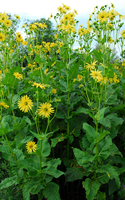Cultivation of rapid growing, perennial plant species for biomethane production
Bioenergieregion Bayreuth
From 01/2009 to 12/2014Principal Investigator: Pedro Gerstberger
 Due to the guaranteed bonus payment for the production of electricity power with biogas the cultivation of maize (Zea mais) in Germany, for biomethane (CH4) production has increased tremendously in the last few years. As a C4-plant maize has a high biomass yield. Maize production is however associated with a lot of ecological and environmental problems, which include increased degradation of soil humus, increased soil erosion, nutrient leaching, increased soil compaction, decreased soil fertility and high pesticide input. In addition, maize crop also faces the challenge posed by the increasing numbers of destructive insect or fungus pests as well as damage caused by increasing populations of wild boars.
Due to the guaranteed bonus payment for the production of electricity power with biogas the cultivation of maize (Zea mais) in Germany, for biomethane (CH4) production has increased tremendously in the last few years. As a C4-plant maize has a high biomass yield. Maize production is however associated with a lot of ecological and environmental problems, which include increased degradation of soil humus, increased soil erosion, nutrient leaching, increased soil compaction, decreased soil fertility and high pesticide input. In addition, maize crop also faces the challenge posed by the increasing numbers of destructive insect or fungus pests as well as damage caused by increasing populations of wild boars.
 Most of these problems can be avoided through the cultivation of perennial crops with high biomass yields. After initial establishment of stock cultures, the plants are repeatedly harvested for more than 15 years with very low maintenance costs and inputs.
Most of these problems can be avoided through the cultivation of perennial crops with high biomass yields. After initial establishment of stock cultures, the plants are repeatedly harvested for more than 15 years with very low maintenance costs and inputs.
Since 2009, the department of Plant Ecology of the University of Bayreuth has been experimenting with 10 different fast growing perennial plant species to determine their biomass yields per hectare and methane production capacity (per kg organic dry matter). The plant species under investigation are wild, poorly lignified perennials from central Europe, eastern Asia and North America with no special soil or climatic condition requirements. The plants are fast-growing and attain heights of 1,80-2,50 m already in their second and third year of growth.
Yields are usually still low in the first year of growth. In their second year there is no requirement for further herbicide application since they shade most of the ground surface with their large leaf mass. In the third year they attain yields of up to 20 t/ha of dry matter. The fields are fertilized once a year (in March) with the residues from the bio-digester. Thus a short, environmentally friendly, closed cycle is performed.
 Harvesting is done with commercial maize shredders. Due to the dry matter content of about 30 % at the end of September, the shredded plant material can easily be converted into silage. All the plant species selected for the evaluation are frost tolerant in central Europe and re-sprout in March. They also have a longer standing biomass period on the fields and hence minimise soil erosion. The cultivation of the perennial plants is, therefore, also recommended for water catchment areas.
Harvesting is done with commercial maize shredders. Due to the dry matter content of about 30 % at the end of September, the shredded plant material can easily be converted into silage. All the plant species selected for the evaluation are frost tolerant in central Europe and re-sprout in March. They also have a longer standing biomass period on the fields and hence minimise soil erosion. The cultivation of the perennial plants is, therefore, also recommended for water catchment areas.
Due to less intensive cultivation demands by the perennial cultures, considerable cost reduction can be achieved. In comparison, the perennials are ecologically, and in parts economically superior to the maize. First trustworthy results concernig the exact yields and agricultural conditions will be presented in about 3 years.
The research is financed by the Oberfranken-Stiftung and the German Federal Ministry of Nutrition, Agriculture and Consumer Protection (BMELV) within the framework of the bioenergy region of Bayreuth.

Upcoming ...
| BayCEER Colloquium: |
|---|
| Th. 2024-04-18 Survival, 'dormancy', and resuscitation of microorganisms in water-limited environments: insights from coastal salt flats and desert soil crusts |
| Th. 2024-04-18 The Canvas of Change: Creative Marketing for Behaviour Change, Sustainability and Social Good |
| BayCEER Short Courses: |
| Tu. 2024-04-16 now Geographical information system and R environment for conservation biology |
| Ecological-Botanical Garden: |
| Fr. 2024-04-19 Führung | Gesteine im Ökologisch-Botanischen Garten |
| Su. 2024-04-21 Führung | Den ÖBG kennenlernen: Allgemeine Gartenführung |







